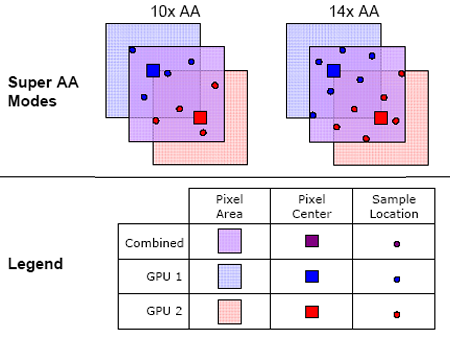ATI's Multi-GPU Solution: CrossFire
by Anand Lal Shimpi & Derek Wilson on May 30, 2005 9:00 PM EST- Posted in
- GPUs
Super AA Modes
There are some older games that wouldn't see any benefit from a multi-GPU solution, as these titles may not be GPU limited. In order to provide some benefit to these games (while at the same time offering higher image quality), ATI has devised four multi-card display modes. These modes are user selectable from the control panel and can help add smoothness and clarity to any title.The compatibility of ATI's Super AA modes is not limited to any subset of titles because there is no workload split involved - each card renders the entire scene, each with a unique set of sample points. Before display, the compositing engine takes the output of each card and prepares a final image for display.

Two of the new modes simply make use of different sample points. 8xAA and 12xAA employ either 4x or 6x AA modes on each card. Of course, MSAA is limited in its ability to antialias certain aspects of a 3D scene. Multisample only works along polygon edges, while the slower supersample method works across the entire scene (including textures). SSAA has fallen out of use due to the rather large performance impact that it has on a single card. The modus operandi for SSAA is to render a scene at a higher resolution and then resample the image to the desired resolution. Of course, there are other ways of performing SSAA.

ATI is able to handle SSAA by rendering the entire scene at the desired resolution on each card with a half pixel diagonal shift. They combine this method with either their 8x or 12x MSAA modes in order to produce 10xAA (4x + 4x + 2xSS) and 14xAA (6x + 6x + 2xSS). These quality modes should prove to be phenomenal.
These 2xSS mode shouldn't be confused with a normal 2x vertical and 2x horizontal resolution mode. In that case, each pixel has 4 ordered sample points that scale down to one pixel. In ATI's mode, 2 sample points are used per pixel in a rotated grid fashion.
These modes add life to games that would not benefit otherwise from multiple graphics cards, as well as provide a compatibility mode to titles for which alternating or splitting frames is not an option. This is a key feature of ATI's CrossFire that separates it from NVIDIA, and we are very eager to get our hands on hardware and test it first hand.
Now that we know what ATI's CrossFire solution is and what it can do, let's take a look at how it stacks up to the competition.










57 Comments
View All Comments
bob661 - Monday, May 30, 2005 - link
#5Try it and let us know.
ksherman - Monday, May 30, 2005 - link
so... does this man I can use the CrossFire tech on my DFI nF4 Ultra-D? since the limiting factor in making it SLi worthy was the SLi bridge, ATI's doesnt need one... and is it fully compatible with nForce4?Zebo - Monday, May 30, 2005 - link
Like a dongle is a big deal with the 95 cables already hangin out the back of my case...Slappy00 - Monday, May 30, 2005 - link
What ever happened to the Wicked Stepsister?looks good but with next gen consoles around the corner I think im gonna put my money towards a AMD 64X2 and a PS3/XBOX 360 rather than shelling out a grand for some extra frames.
AnnihilatorX - Monday, May 30, 2005 - link
"First" Second Postmattsaccount - Monday, May 30, 2005 - link
Bout time ATI gave us something.error4656 - Saturday, December 5, 2020 - link
this shit is old